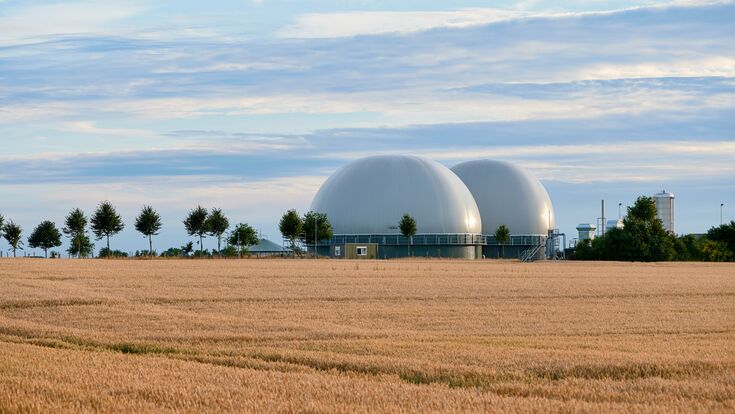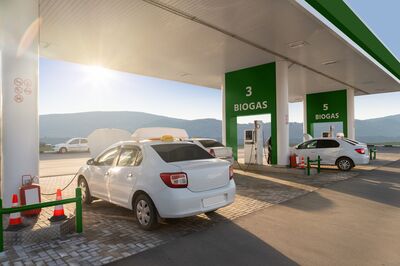Biomethane in the US : The Renewabele Natural Gas Sector is growing fast

How is biomethane viewed in the US?
In the US we call it renewable natural gas or RNG, but it's the same thing. I would say there are two ways to answer what's happening with the RNG industry in the US.
One is it's growing faster than it ever has, and that is due in large part to two transportation-related policies that we have in place. There's a federal policy that encourages the production of renewable fuels for transportation and there's a state policy that encourages the fuels that go into vehicles to be decarbonized. So, one of them is just on the production of renewable fuel from all different kinds of biomass and the other is decarbonising the transportation sector. In that way, it's one of the few places in the US where we do have a price on carbon. And that's driving massive growth in renewable natural gas projects and production.
It has particularly impacted the landfill gas sector. There are a lot of landfills, that have been producing electricity, that are switching over to producing renewable natural gas instead to take advantage of these more lucrative markets. And some landfills couldn't be bothered to buy engines and produce electricity and are now utilizing their gas. That is a positive development.
But while they produce large volumes of gas, the number of landfill opportunities is much smaller than the number of anaerobic digester opportunities in the US. I think there are about 600 landfills that are not utilizing their gas. We count 15.000 new digesters that could be built. The reason for that is we are hardly recycling any of the organic material that we produce in the US. Food waste, wastewater sludge, manure: very, very little of its being recycled, and so that creates a huge opportunity for RNG in the US.
What other factors are driving the growth in RNG production?
So those two transportation policies are really driving the growth of the RNG sector in the US for transportation, but another market has opened up recently, at least in the US. There's an investment standard called ESGS, which stands for environmental, social, and governance, and it's a combination of environmental and social standards that corporations have to meet for being environmentally and socially responsible. And if you meet the ESGS standards that are kind of set by the investment community, then you are eligible for some funds and some indexes of companies. And the number of ESG funds is growing every day. And so, as a large corporation, if you don't have ESG standards, your investment potential decreases, and your investment opportunities are decreasing.
We've got these companies that need to meet standards. On the energy side, that means lowering your carbon footprint. On the environmental side, it means lowering our carbon footprint. And if you're a large corporation that's using electricity, you've probably already figured out how to buy renewable electricity. We have a lot of deregulated markets where it's relatively easy in the US to choose to buy renewable electricity instead of the conventional grid mix of electricity. But that opportunity barely exists for gas. There are only very, very few places where you can just quickly choose to buy renewable gas instead of conventional gas. And so as a corporation if you want to lower your carbon footprint and you need heat to make your products, gas is one of the only ways you can make heat efficiently and if you need to lower your carbon footprint, renewable natural gas is one of the only ways to displace conventional gas used to get the heat that you need to make your products and meet ESG standards.

So large corporations that are active in the US investment market are demanding from their gas utilities to be able to buy renewable natural gas, and that's created a voluntary RNG market separate from the transportation market. There's an RNG voluntary market that's largely driven by corporations wanting to meet the ESG standards and they are seeking out renewable natural gas to buy. And that's creating a huge opportunity.
Read here what Dirk Bonse, Head of the Department for Renewable Gases at the German Biogas Association, has to say about the future of biomethane production.
Gas is one of the only ways you can make heat efficiently. If you need to lower your carbon footprint, RNG is one of the only ways to displace conventional gas used to get the heat that you need to make your products and meet ESG standards.Patrick Serfass, ABC
How are the prices for RNG compared to conventional natural gas?
Right now conventional natural gas in the US is about three dollars per million BTU (MMBTU). And if you sell into the transportation market, that gas could be worth like nine to $60 per MMBTU. So it's a lot, but those transportation markets are both variable, because the value for that nine to $60 comes from the credits that you generate from those two programs, and the value of those credits can fluctuate quite a bit. So the upside is huge, but the risk is significant.
For the voluntary RNG market, you're most likely to be getting a price that's like nine to $15 per MMBTU. So compared to three-dollar gas that's still great and you're generally getting long-term fixed-price contracts. And so what you have is one market that is really good for investors that have a high-risk appetite and a high reward potential. And then you've also got a market that's good for your more conservative investors in the voluntary market. Now that the voluntary market is still relatively new, it's growing quickly.
The existence of those two markets is fueling continued growth in RNG because obviously, you're appealing to both of your main kinds of investors and people in between. You can choose to sell some of your gas to the transportation market and some of it to the voluntary market, and then you get the best of both worlds. I guess that's a macro vision of what's happening with RNG right now.
Do gas customers also favor RNG?
Yes, gas customers are asking their utility to buy renewable natural gas. Ratepayers more and more all over the US are asking for gas utilities to be decarbonised, and so there's this third opportunity that's happening, which is driven by this ESG interest by corporations, which are utilities buying gas for themselves to be able to sell to all kinds of customers. And they want to do that because they need to decarbonise our gas pipelines in the US because there is an increasing interest in climate change.
The newly signed Inflation Reduction Act (note: it became law on August 16, 2022) will accelerate the US's ability to meet climate change goals. There's a growing sentiment in the US to decarbonise our energy sector. We’ve been decarbonising electricity for a long time. But the gas sector needs a lot of work to decarbonise. So that's another opportunity, which is utilities buying the gas, utilities, investing in new projects to make sure that they have their hands on gas supplies. That's the same as utilities investing in fracking or a gas well. They're investing in biogas systems so that they have control of the supply of this renewable gas. And then, once utilities do that, not only are they reducing their carbon footprint but now they're asking the utility commission for permission to resell the gas.
Now they can not only sell their gas to large customers to meet those ESG goals, but now they can start offering gas to customers, to anyone, to individual, residential customers to buy. That's also creating an opportunity for growth.
Are there also factors hindering the growth of the RNG sector?
Yes. On the other side of this, in our more liberal states, California, and New York, principal among them, there is a growing, not logical interest to electrify everything. So anything electric-based is better than anything gas based. And people who believe in electrifying everything and not just electrifying more, don't understand how much renewable natural gas and biogas systems are needed, not only to reduce greenhouse gas emissions in our society but how much that infrastructure is needed to recycle all the organic waste that we produce.
So it's doing something that helps the industry and something that hurts the industry. The thing that's hurting the industry is it's pushing some politicians to stop gas use and stop the gas connection, even renewable gas, just because it's gas. There's this anti-combustion mentality that is growing in some parts of the US. And again it doesn't make logical sense. California has blackouts and brownouts all the time because its electric grid isn't strong enough.
What is helping the biogas industry?
Biogas systems can make electricity 24/7 too. We don't have to make renewable natural gas. And so while we're riding this wave of renewable natural gas growth in the US, there is also a growing interest in making electricity.
The only problem is it's just interesting right now and there are not yet really lucrative opportunities for biogas electricity projects. But that will probably be changing in the next 18 months.
In the landfill space that presents a little bit of a conundrum. You know, do you invest more in renewable natural gas and continue riding this wave of growth, which will probably continue for many years? Or do you wait for a market that is not currently very lucrative? But means you wouldn't need to have any additional capital costs if you're already producing electricity. Do you wait for those electricity markets to become more lucrative? It's an interesting space if you're in landfills. For example, Waste Management (WM), who is on our board, have already committed almost a billion dollars investment in switching many of their electricity-generating landfills over to RNG because they see more growth potential on the landfill gas side of their business than they do in the waste hauling business.
So the good news is that there's opportunity everywhere and it's a good time to be in biogas.
Biogas systems can make electricity 24/7 too. And so while we're riding this wave of renewable natural gas growth in the US, there is also a growing interest in making electricity.Patrick Serfass, ABC
Do you also see that biogas operators are switching to the RNG?
Yes, nine out of every 10 biogas projects in development right now are being developed as RNG projects.
Are there any grants that help start those projects?
Every one of our 50 states is a little bit different. But there are grants available as well as some federal grants. But that's not what's driving the industry. What's driving the industry are these macro-level policies. And even though the California policy is a state policy, it's so impactful. It's driving development all around the country. Because you don't have to sell your gas in California to be able to participate in the program.
On the road away from fossil fuels: Read our article on RNG technologies and the future of biomethane production.
What impact will the newly signed Inflation Reduction Act have?
The Inflation Reduction Act is full of some grants. But the main impact on the industry is the tax credits. There are some new tax credits in there and there's some long-term extension of some existing tax credits. Those tax credits also only affected the electricity generating side of the industry, which we mentioned earlier, is not the lucrative side of the industry.
So now there are going to be tax credits for RNG projects as well. But it's brand-new and the way the legislation is written is pretty confusing. But what matters the most is, what our Treasury Department actually writes. For example, when the Treasury says biogas systems get a tax credit, do they mean the whole system from taking in the feedstock to digesting it to producing RNG or electricity or whatever, or do they only mean the digester? That right now is not clear and that will have a huge impact on how big the tax credit can impact the industry. But it will definitely do positive things.

But, likely, the Inflation Reduction Act will accelerate the growth of the biogas industry. We're optimistic that that will happen, but we're still trying to understand how the legislation will work in practice for our members.
Is it feasible for a middle-sized farm to have its own AD plus RNG production?
It depends on a lot of different factors but mostly on the volume of gas that's produced because the equipment to upgrade biogas to renewable natural gas does not scale down very well. So, it's harder for RNG equipment to work on individual small farms. But if those farms cluster together and all send their gas to one upgrading spot, then it becomes feasible. And so that's what we're seeing.
Denmark is a prime example. They don’t have any large farms but they have huge biogas systems. They have biogas systems that are two to three times as big as our largest digesters and we've got some big digesters. But the reason that they have that is that they've gotten good at clustering.
Biogas and biomethane are also gaining ground in Italy. Read our article here!
How difficult is it permit-wise and technically to inject the RNG into the grid?
Technically it's very easy. Permitting and cost-wise it varies. Because of what we talked about earlier about the growing motivation of gas utilities to decarbonize their pipeline system, over the last two to three years, the interest in helping biogas systems interconnect into the gas grid has changed enormously. It's so much easier now than it was just two years ago. But it's still 10 times more expensive to interconnect in California than it is anywhere else in North America. And there are still some utilities that just don't want to be bothered by gas interconnection and they're just kind of slow to change.
So when you're developing a project it is really important to check with the utility, to get a sense of their appetite for interconnection, because while a lot of them are very anxious to interconnect and are trying to attract projects to their state to interconnect because they want to get renewable gas, some are ambivalent and some are resistant.
Where do you find the most biogas and RNG plants in the country?
It's primarily been driven by the dairy and the swine sector so far. So, you have them a lot where there's a lot of agriculture. And then food waste and wastewater are proportional to the population, and so you have those in urban areas. But there's not a geographic center.
Is there a main feedstock?
It really is everything. We've got 2300 operational biogas systems in the US right now and 1300 of those are wastewater plants. And while only about 70 of them are food waste only plants, probably a third to a half of the biogas systems take in food waste in some form. Manure projects are really popular as well because they perform well under those two transportation-related policies that I mentioned.
What about small-scale anaerobic digesters? Read our article here!
Is there also a market for the digestate to be sold as fertilizers?
We are trying hard to develop that market. Especially now that the Russian invasion of Ukraine is boosting fertiliser prices and therefore food prices. Politically this seems like a great opportunity to focus our politicians on how much natural fertilizer can be produced domestically with biogas systems.
We're trying to sell that idea right now and we're trying to increase interest in digestate. But those markets have not grown yet. And it's sad because the material is so valuable and it's just an educational issue. People just don't know how valuable it is. There's virtually a package of safe, odorless, nutrient-rich material. I put it on my lawn and in my garden and it is amazing.
What happens now to the digestate?
It gets used, but it just gets given.
So it's not revenue, it’s a cost.
Yes. But it's a lot cheaper to give it away than it is to landfill it and it's better for the environment too. I think it's just going to take time. The more biogas systems that get built, the more people that are going to be using the digestate. The more people that are using digestate, the more people will recognize how great it is, and then eventually markets will develop.
I haven't met anyone that doesn't love it and says that it's the most amazing material to make the crops grow. Some studies show that digestate boost crops by up to 10 to 30% compared to chemical fertilizers. We've got one digester owner who says that they're getting an extra harvest of hay a year since they started using digestate. It's got to catch on, but it hasn't yet.
Some studies show that digestate boost crops by up to 10 to 30% compared to chemical fertilizers.Patrick Serfass, American Biogas Council
What are the technologies most used to upgrade to RNG in the US?
There's no dominant technology. I know in some countries there are some dominant technologies, but that hasn't happened here in the US.
How much of the gas can be supplied by RNG?
It's a difficult question to answer because the amount of gas usage in general in the US is changing so much. After all, we have super cheap conventional natural gas and we are a net exporter. I think we are in the top three for natural gas production in the world. Gas usage has been increasing and therefore the percentage that RNG can cover ends up changing. So it's hard to give a percentage but based on current gas use RNG could make up 10 to 30% of our gas use. But that percentage will increase as we're using less conventional gas in general and are using more electricity.
How necessary are policies like the Inflation Reduction Act for the RNG industry?
Well, the policies aren't needed to make biogas, renewable natural gas, successful on their own. The policies are needed to equalize the playfield compared to fossil fuels and other renewables. That's where politics is needed so we can compete fairly with them. There are lots of examples in the US where solar and wind are given a massive advantage over other renewables, and so makes it harder for other renewable technologies to compete sometimes for financing and customers. That's where policies are most needed and also to address climate change. I think we've shown that US corporations and citizens are not going to address climate change on their own. So, policies are needed to make sure that we're meeting our climate change goals as well. And as that happens, that should create opportunities for biogas systems because they can reduce greenhouse gases so much. We can recycle organic material the way almost no other technology can. We have a unique value in addressing environmental sustainability and climate change.
Do you know how much greenhouse gases can be reduced?
It depends on a lot of different things. But to use a transportation example, here biogas systems can reduce emissions compared to a gasoline or diesel vehicle, between half and seven times.
Compared to other renewable fuels, do you think that RNG stands out?
Yes, especially in the transportation space. That's because you're reducing the greenhouse gas emissions from the material you're making it from and at the vehicle. So you're getting a double benefit.
How do you see the future for RNG? Do you think it will continue to grow?
There's no sign in the next five to 10 years of that growth slowing down. Of course, you never know what might happen, but there's no sign of it yet. And, if anything, with the recent policies, we expect it to accelerate over the next several years.

About Patrick Serfass:
Patrick Serfass is Executive Director of the American Biogas Council (ABC). Patrick has led the American Biogas Council since it was formed in 2010. The ABC now represents over 200 organizations and has a network of more than 15,000 stakeholders in the biogas industry. In addition to biogas, Patrick has nearly 20 years’ experience growing clean energy industries, like solar, hydrogen, and woody biomass, through the company that manages the ABC, Technology Transition Corporation. Patrick holds a Bachelor of Arts in Engineering Sciences from Dartmouth College.



